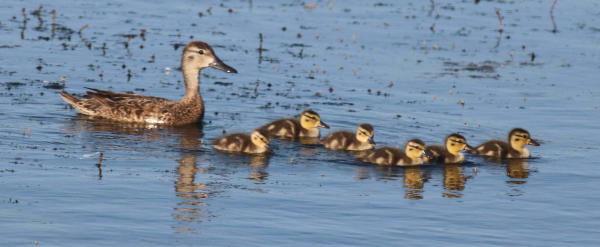
Blue-winged Teal and brood of ducklings

Common Tern
|
Peter began this week’s visit: Hey Paul, this was our family vacation week at the South Carolina coast! I enjoyed most of my birding at the end of a 250-foot boardwalk across a saltmarsh that ended at a tidal creek. Shorebirds are already migrating south and I saw several small flocks of Whimbrels, a few Black-bellied Plovers, Short-billed Dowitchers and Least Sandpipers – all species that nest in the Arctic tundra. A couple gaudily-plumaged American Oystercatchers were in residence.
The “terning” was great! A nearby state park provides a nesting area for Least Terns, and my high count for the week was 99 resting on a sandbar. At the other end of the size spectrum were the Caspian Terns that hunted up and down the creek. Royal Terns were common and each day I saw at least a couple Sandwich Terns. Common Terns were also fun to watch in flight. But I missed Black Terns and Gull-billed Terns, both of which were possibilities for the area.
The marsh was filled with wading birds. It was not unusual to have five species in view simultaneously, each pursuing fish and other prey in their own way: Great Blue Herons, Little Blue Herons, Green Herons, Great Egrets and Snowy Egrets. One evening both Black-crowned and Yellow-crowned Night Herons flew by, and small flocks of White Ibis and Glossy Ibis also flew up and down the marsh.
A pair of adult Bald Eagles harassed Ospreys for the fish they caught, providing some aerial excitement; but I think I had the most fun watching Clapper Rails. At high tide they would swim from one area of high ground to another, looking like small Loch Ness Monsters with their head and long bill showing above water, then a few inches further back, their tail. They are actually good swimmers!
What a great week, sitting at the end of the boardwalk with a book and binocular, watching the birds go by, sometimes with my wife or other family members – what fun!
Paul quickly responded: That’s exciting Peter, and here I am, as far away from an ocean as you can be, in the center of the continent. But the avifauna is every bit as diverse here in the prairie-wetland complex of Dakota. This season it’s been obvious there are many more American Bitterns in the area. During early spring I encountered several individuals, and even photographed a bittern perform an impressive wing-flapping display punctuated by its unusual call that I’ve never witnessed before. Now, the vegetation is tall and thick, so it’s hard to find a bittern in the open; but I seem to see a different American Bittern in flight during each of my daily drives south of home.
The local rails have been vocal, especially Soras, but they are especially hard to see in their usual haunts among the thick cattails, bulrushes and sedges. I had a surprise sighting yesterday morning when a Virginia Rail popped out of thick brome grass dripping with heavy morning dew. That’s what rails and bitterns are all about though – they are secretive, wary and hard to find, making them a memorable sighting and favorite calls to hear in the marshes.
The nesting prairie hawks I’ve monitored in the area have been successful in raising their nestlings. The Ferruginous Hawk nestlings are feathered and should begin leaving the nest during the next week. The Red-tailed Hawks in the area may take a little longer. The Swainson’s Hawks are always a couple weeks behind due to their late spring migration into the area, but they tend to have the prettiest fledglings, so I look forward to photographing a few during their post-fledging period.
The most obvious nesting birds in the area are the ducks, and the number of broods increases each day, with Blue-winged Teal most abundant now, followed by Mallards. More Gadwall and Northern Shoveler broods have been active, and a couple more Northern Pintail broods have been obvious. Finally, I found my first diving duck brood Saturday evening, a brood of little Ruddy Ducks. And Sunday evening I found my first Lesser Scaup brood, almost black in color. There is a considerable age spread from brood to brood now, with some ducklings aged 6 weeks and resembling feathered adults already, while new downy ducklings appear each day, following behind the hen and instinctively pecking small aquatic insect larvae from shallow water.
At home, orioles continue to dominate my summer feeding station. Recently female Orchard Orioles have been visiting more often, and this week I noticed a different pair of Baltimore Orioles stop by a couple times one day. I expect a pair of Baltimores and a pair of Orchards are nesting nearby, and I’m hoping fledglings will check out some grape jelly with the adults. I’ve also been seeing many Orchard Orioles in the field lately, and this week most of them were carrying insects, indicating they are in the thick of raising nestlings. A male Ruby-throated Hummingbird has persisted through the summer season, but I expect more hummers to assemble soon as the nesting season winds down.
While most birds are still nesting, some species are beginning to assemble in post-nesting flocks, especially Franklin’s Gulls, Yellow-headed Blackbirds and male Wood Ducks. It’s interesting that Wood Ducks rarely nest in this area, but male Woodies tend to assemble in some area wetlands to molt their breeding plumage. Some other male ducks are also beginning to molt into their summer eclipse plumage, but to date they haven’t assembled in molting flocks.
Here in the northland, the landscape and bird behaviors change quickly with the shortened seasons. I tend to savor each change and each birding drive, and I hope you’re enjoying some fun birding episodes at home and in the field.
Peter Stangel and Paul Konrad are the editors of The Birding Wire. Share your recent birding experiences and photos with Paul and Peter at editorstbw@gmail.com